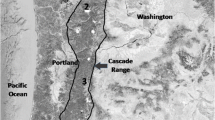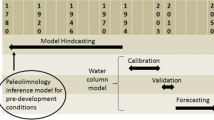Abstract
Limestone dissolution efficiencies and reacidification rates observed in ten small Adirondack Mountain lakes, treated in 1983 to 1984 as part of the Extensive Liming Study (ELS), were compared with Scandinavian model predictions of dissolution (Sverdrup and Bjerle, 1983), and reacidification (Wright, 1985). The standard deviation of predicted initial dissolution was 15.4% of the observed fraction of limestone dissolved. Model predictions of dissolution for the Scandinavian lakes were similarly within 8 to 14% of observed values. Further analysis of the ELS data indicated that of the dissolution model parameters, dose rate alone was the best predictor of initial dissolution efficiency. Dissolution rates declined exponentially with time to undetectable levels within 2 to 3 yr following treatment. Total limestone dissolution efficiencies were in the range of 17 to 59% for the ELS lakes, which are comparable to levels observed in Scandinavian treatments with similar limestone materials (26 to 64%). Analysis of data from other Adirondack lakes limed by private groups and the New York State Department of Environmental Conservation for fisheries management programs, yielded similar estimates of dissolution efficiency for calcite based materials (average 36%). However, some of these lakes which were treated with slaked lime [Ca(OH)2], exhibited initial dissolution efficiencies approaching 100%. The simple two box dilution model of reacidification, satisfactorily predicted Ca loss rates in the ELS lakes, indicating the importance of hydrology (water retention time) as a factor controlling reacidification rates in these small, limed lakes. For the ELS lakes, the ratio of watershed area/lake volume satisfactorily predicted Ca loss rates (R2 = 0.96) and this simplified empirical model was applied to other Adirondack lakes where inadequate water chemistry and hydrologic data were available to utilize the dilution model. Limed Adirondack lakes with mean water retention times less than 4 mo reacidified within 1 yr after treatment. Given the preponderance of acidified lakes in the Adirondack region with retention times less than this threshold value of 4 mo (approximately 80% of lakes <10 ha surface area), simple whole lake liming practices would not be adequate for maintaining water quality suitable for the support of viable fish populations in these lakes.
Similar content being viewed by others
Rights and permissions
About this article
Cite this article
Gloss, S.P., Schofield, C.L. & Sherman, R.E. An evaluation of New York state lake liming data and the application of models from Scandinavian lakes to Adirondack lakes. Water Air Soil Pollut 41, 241–278 (1988). https://doi.org/10.1007/BF00160353
Issue Date:
DOI: https://doi.org/10.1007/BF00160353




